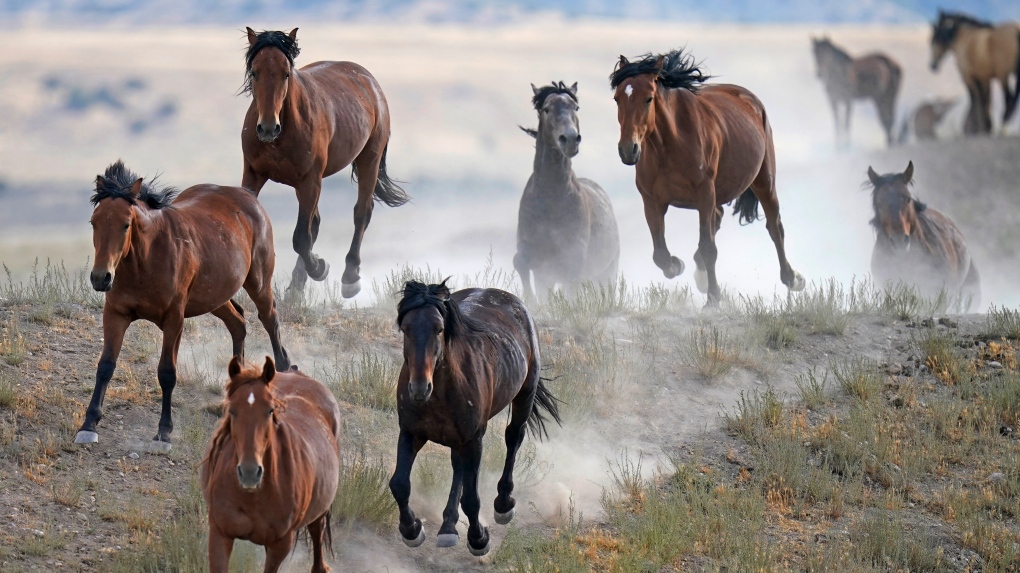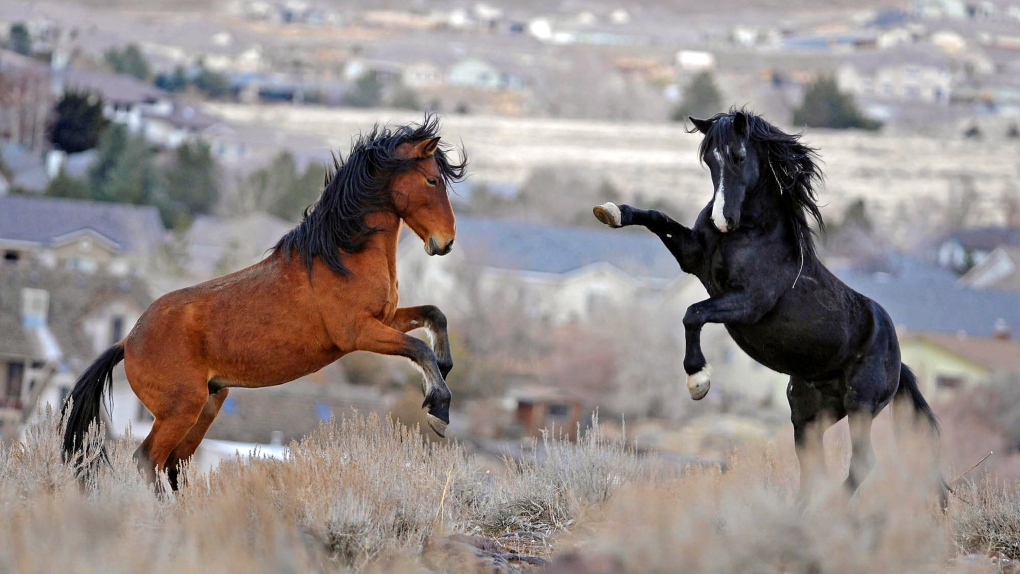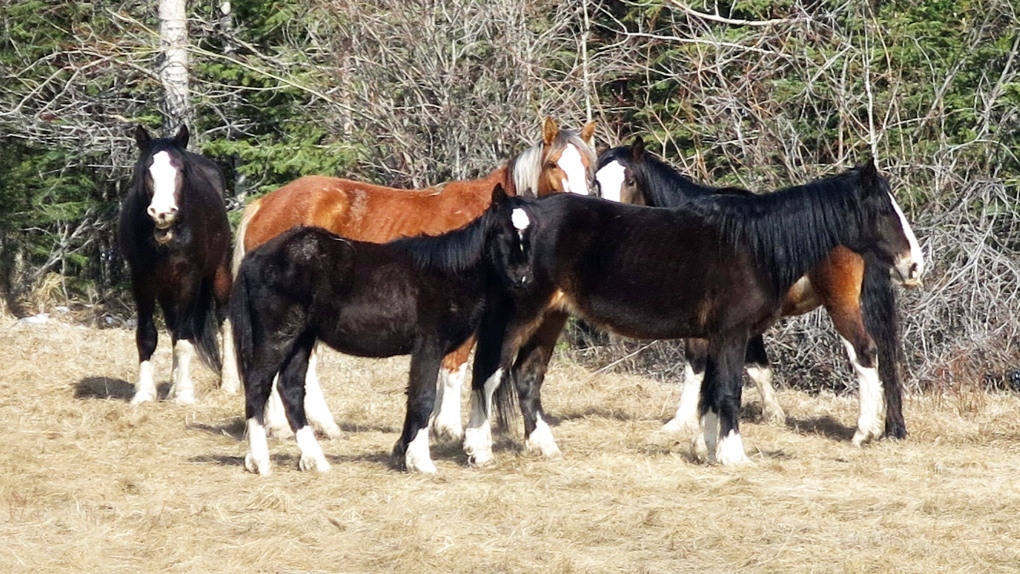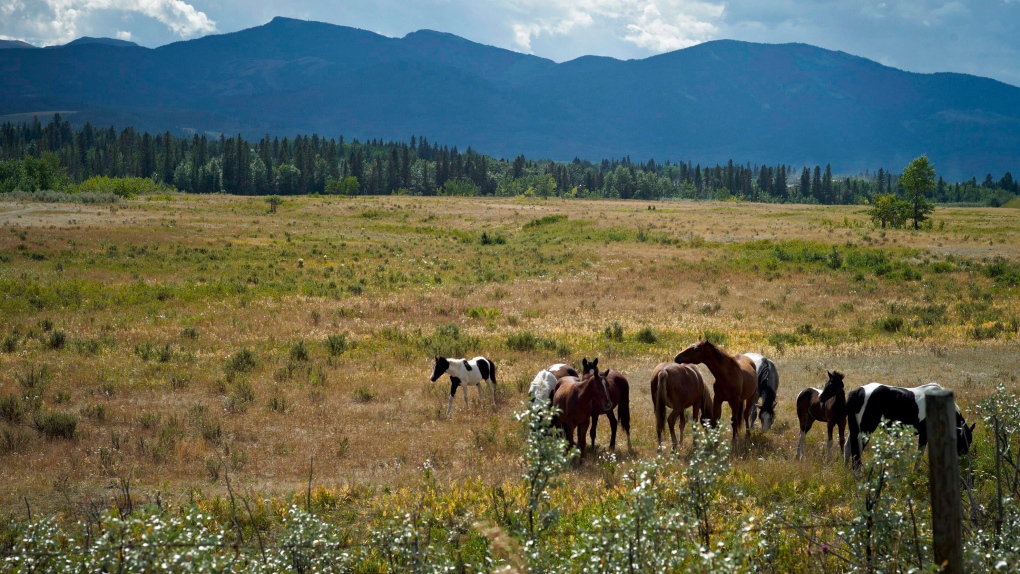Feral horse count in Alberta district past threshold according to new management plan
 A wild horse stallion looks on warily on crown land near Sundre, Alta., Wednesday, Dec. 11, 2019.THE CANADIAN PRESS/Jeff McIntosh
A wild horse stallion looks on warily on crown land near Sundre, Alta., Wednesday, Dec. 11, 2019.THE CANADIAN PRESS/Jeff McIntosh
Alberta has historically looked a bit like the Wild West when it comes to handling its free-roaming horse populations, but advocacy groups are optimistic about a new provincial management framework to protect the iconic animal in the foothills it roves.
The feral horse management framework introduces population thresholds across six equine management zones, including the Ghost River area, covering most of the M.D. of Bighorn.
Where feral horses have been culled in the past for being considered too numerous and causing harm to the environment, Darrell Glover, founder of the Helping Alberta Wildies Society (HAWS), said implementing more effective contraception methods and adoption plans for humanely captured animals is a positive step forward.
“We're really happy to get the opportunity to get them first,” he said. “Right now, there's only two capture licenses issued in Alberta, and one of them is ours.
“If there are horses that need to be removed, the government will contact us or WHOAS (the Wild Horses of Alberta Society) to deal with that. That's obviously our preferred method. We won't ever allow a horse to go to a slaughterhouse again.”
The foothills have an estimated population of 1,400 feral horses, according to Alberta Forestry and Parks minimum counts completed by zone flyovers in 2023.
The Ghost River zone has a population of about 311 feral horses, according to the count. The framework categorizes this number as requiring active management to keep the population under a determined cap of 400 animals in that area.
Based on population counts and specific thresholds classified in three tiers (green, yellow, and red), all management zones except one are in the yellow and require active management.
This includes utilizing contraception, adoption and monitoring programs to control populations in balance with other land uses.
The first threshold is based on unallocated forage available, which can be grazed by feral horses without harming rangeland functions, biodiversity, and multi-use. Populations under this threshold are considered ecologically sustainable and need no active management.
If a population reaches its cap, which is determined per zone, it falls in the red and the province will review licensed captures, sales of horses and “other measures as necessary” in that area, according to the framework.
“Alberta's government remains committed to a responsible rangeland management system that supports many land uses, including recreation, forestry and resource extraction, wildlife, livestock and feral horses,” said Alberta Forestry and Parks spokesperson Christi Retson-Spalding in an email.
“We strive to achieve a balance of these uses to ensure rangelands do not become degraded.”
 Free-ranging wild horses gallop from a watering trough on July 8, 2021, near U.S. Army Dugway Proving Ground, Utah. (AP Photo/Rick Bowmer)
Free-ranging wild horses gallop from a watering trough on July 8, 2021, near U.S. Army Dugway Proving Ground, Utah. (AP Photo/Rick Bowmer)
Prolonged grazing by species such as horses can change a native grassland to have less adaptable and less palatable grasses for other wildlife and livestock, which share the land.
A 2022 study from the University of Saskatchewan, Feral horse ecology in the Rocky Mountain Foothills of Alberta, Canada, looked at the carrying capacity of the province's foothills for the grazing species, which feed primarily on grasses.
It reviewed evidence of harm from feral horses in other parts of the world, such as Australia, where a growing population of non-native species on the landscape is threatening native species, despite ongoing culls and reduction targets.
While the study acknowledges an overpopulation of horses can harm ecosystems, it also highlights there is insufficient research and real data on the ecology of feral horses in Canada.
This has resulted in a commonly preconceived judgement that horses should be removed “because they are non-native and therefore have negative impacts on ecosystems,” the study states.
“This departure from an empirically based approach to research, impact assessment, and decision-making regarding feral horses indicates that conservation ideologies and research can be self-fulfilling and suggests that requests from advocates for scientists to validate their nominally objective claims about wild horses are warranted.”
The framework was developed by an advisory committee including HAWS, WHOAS, Stoney Nakoda First Nation, RCMP, the University of Alberta, environmental groups such as the Alberta Wilderness Association, as well as livestock and logging stakeholders.
Until 2015, the former Alberta Environment and Parks managed feral horses by removing them via capture licences where they were deemed overpopulated and causing ecological damage.
“Although full records are incomplete prior to the establishment of the legislated management system, over 2,100 documented horse removals occurred in the Eastern Slopes since the 1960s in response to natural resource concerns,” states the management framework.
 In this Jan. 13, 2010, file photo, two young wild horses play while grazing in Reno, Nev. (Andy Barron/Reno Gazette-Journal via AP)
In this Jan. 13, 2010, file photo, two young wild horses play while grazing in Reno, Nev. (Andy Barron/Reno Gazette-Journal via AP)
In the early 1990s, concerns over horse mistreatment during capture on public land prompted the province to establish capture regulations under the Stray Animals Act, ensuring humane treatment and banning cruel capture methods like snares.
The feral horse framework is consistent with the act and aims to guide the management of feral horses as a species alongside other species that have management plans such as grizzly bears, which have been known to prey on feral horses.
“These combined plans aim to ensure rangeland health and environmental sustainability while balancing social and economic priorities in equine management zones,” states the framework.
Both HAWS and WHOAS, which have been monitoring feral horse populations around Sundre since the early 2000s, argued there is little to no evidence of damage due to overpopulation in defined equine management zones, despite nearly all of them requiring active management as defined in the framework, and hoped there would be more evaluation of potential degradation from logging and cattle grazing in the defined areas versus damage by horses.
“The topography is changing, and we can see that through satellite imagery year over year,” said Glover. “This can change the number of horses and other species on the landscape, but I don't think we're going to see any increase in the number of horses. If anything, I think we're going to see more pressure in the years to come to reduce the number of horses again.”
Glover said the population count in Sundre, according to the province, went from 642 feral horses last year to 969 in 2023 - a 51 per cent increase - is a “huge” anomaly. He believes it's due to increased aerial coverage of the zone, thereby adding more horses to the count not accounted for in previous years. The framework sets a cap of 1,000 free-roaming horses allowed in this area.
The Outlook reached out to the Alberta Forestry and Parks ministry to request more information, but had yet to hear back prior to publication.
“Every year, we fly the same flight path the government does. This year, we did the same as we did last year, assuming that's what they were going to do,” said Glover. “For the last two years, we've counted under 700 horses.
“We've challenged them on that because it's misleading to the public. It makes it look like the numbers are out of control.”
 A group of wild horses stand alongside a highway in north central Alberta May 5, 2014. (Bill Graveland / THE CANADIAN PRESS)
A group of wild horses stand alongside a highway in north central Alberta May 5, 2014. (Bill Graveland / THE CANADIAN PRESS)
Glover and Bob Henderson, director of WHOAS, also argued for removing the word `feral' from the species name, saying it downplays the long history of the animal in the province in ranching, rodeo, police work and to Indigenous peoples.
“The biggest thing we will continue to push for is they're not stray animals,” said Henderson. “They've been living on the landscape for generation after generation. We really wish (the province) would finally realize that and give them their own distinct legislation.”
Horses evolved in North America around four million years ago but went extinct during the last ice age about 10,000 years ago, the framework noted. They were reintroduced to the landscape by European settlers in the 16th century.
There are Indigenous groups, however, which argue horses were on the landscape before settlers arrived in North America.
Goodstoney Chief Clifford Poucette said the Stoney Nakoda First Nation, which is comprised of Goodstoney, Chiniki and Bearspaw First Nations, has a long history and a deep bond with the animal that pre-dates European texts.
There are many feral horses on the Nation, in addition to owned horses which some choose to allow to roam freely.
The First Nation shared traditional knowledge of the animal in consultation with the framework's advisory committee.
“We take pride in the wild horses because our ancestors have always respected them. We've hunted on them, raced on them and cared for them for centuries,” said Poucette.
“Many of us, including myself, feel very connected to horses. They're very intelligent, emotional animals.”
Stoney Nakoda First Nation borders the Ghost River equine management zone, however, it is not included in the framework count. Other equine management zones include the eastern slopes west of Calgary (Elbow), Clearwater, Nordegg and Brazeau, east of Banff and Jasper national parks.
 Horses graze on the Eden Valley Reserve, Alta., on Aug. 25, 2011. THE CANADIAN PRESS/Jeff McIntosh
Horses graze on the Eden Valley Reserve, Alta., on Aug. 25, 2011. THE CANADIAN PRESS/Jeff McIntosh
A significant portion of Alberta's feral horse population consists of horses that escaped or were released by First Nations, loggers, ranchers, hunters and miners, and during the onset of the Industrial Revolution, according to the framework.
In an email, Alberta Forestry and Parks said there are currently no plans for capture in any of the equine management zones for the 2023-24 winter season.
CTVNews.ca Top Stories

From essential goods to common stocking stuffers, Trudeau offering Canadians temporary tax relief
Canadians will soon receive a temporary tax break on several items, along with a one-time $250 rebate, Prime Minister Justin Trudeau announced Thursday.
She thought her children just had a cough or fever. A mother shares sons' experience with walking pneumonia
A mother shares with CTVNews.ca her family's health scare as medical experts say cases of the disease and other respiratory illnesses have surged, filling up emergency departments nationwide.
Trump chooses Pam Bondi for attorney general pick after Gaetz withdraws
U.S. president-elect Donald Trump on Thursday named Pam Bondi, the former attorney general of Florida, to be U.S. attorney general just hours after his other choice, Matt Gaetz, withdrew his name from consideration.
Putin says Russia attacked Ukraine with a new missile that he claims the West can't stop
Russian President Vladimir Putin announced Thursday that Moscow has tested a new intermediate-range missile in a strike on Ukraine, and he warned that it could use the weapon against countries that have allowed Kyiv to use their missiles to strike Russia.
A one-of-a-kind Royal Canadian Mint coin sells for more than $1.5M
A rare one-of-a-kind pure gold coin from the Royal Canadian Mint has sold for more than $1.5 million. The 99.99 per cent pure gold coin, named 'The Dance Screen (The Scream Too),' weighs a whopping 10 kilograms and surpassed the previous record for a coin offered at an auction in Canada.
Here's a list of items that will be GST/HST-free over the holidays
Canadians won't have to pay GST on a selection of items this holiday season, the prime minister vowed on Thursday.
Video shows octopus 'hanging on for dear life' during bomb cyclone off B.C. coast
Humans weren’t the only ones who struggled through the bomb cyclone that formed off the B.C. coast this week, bringing intense winds and choppy seas.
Taylor Swift's motorcade spotted along Toronto's Gardiner Expressway
Taylor Swift is officially back in Toronto for round two. The popstar princess's motorcade was seen driving along the Gardiner Expressway on Thursday afternoon, making its way to the downtown core ahead of night four of ‘The Eras Tour’ at the Rogers Centre.
Service Canada holding back 85K passports amid Canada Post mail strike
Approximately 85,000 new passports are being held back by Service Canada, which stopped mailing them out a week before the nationwide Canada Post strike.

































